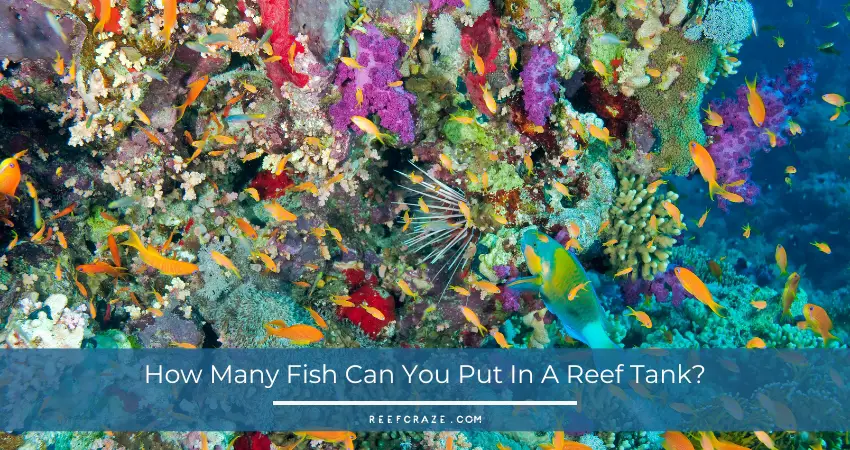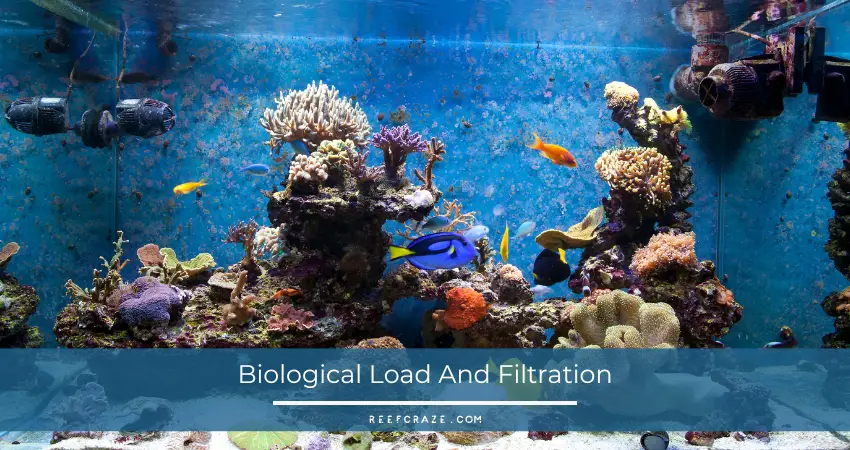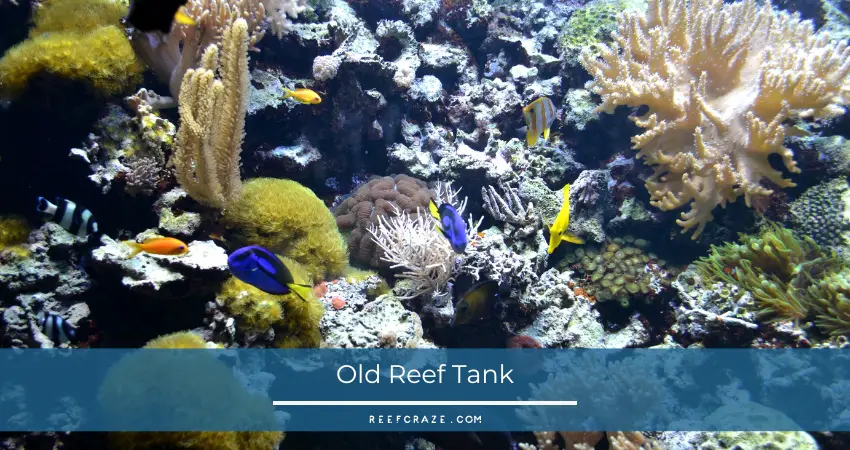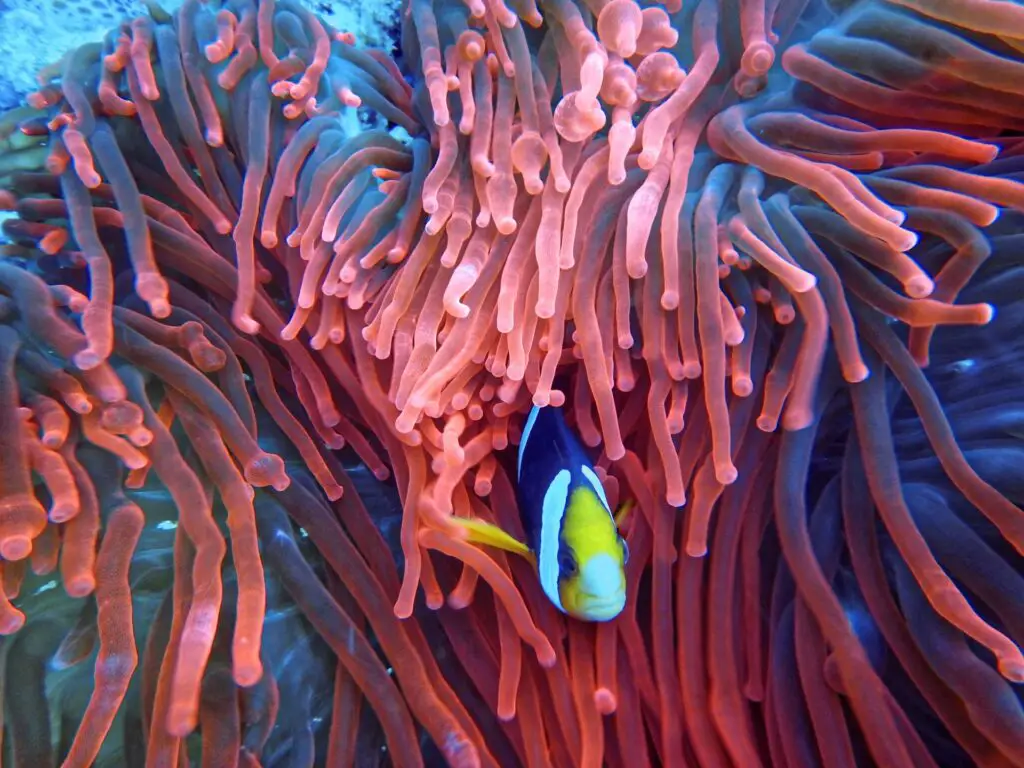The number of fish you can put in a reef depends on the bio-load, the bacterial and algae buildup, fish species, filtration systems, tank size, temperature management, experience, and more.
For a new reef tank, you can add 1 inch of fish per 5 gallons. Tanks over 40 gallons can hold more fish than allotted by this formula as more bacteria and algae tackle the bio-load.
An overwhelming number of people carry problematic misconceptions about keeping fish in tanks. They assume that a single fish won’t require much space or that a visibly large tank can hold as many fish as they desire to keep. It’s so deeply ingrained that even a somewhat informed newcomer assumes there’s a fixed number of fish you can keep per gallon.
I’ll give you an estimate of how many fish by gallons you can keep starting with. I’ll follow it up with more information about 7 factors that decide how many fish you can put in your reef tank.

How Many Fish Can You Add Per Gallon In Reef Tanks?
For new tanks, you can add 1 inch of fully matured fish for every 5 gallons in your reef tank. But the bigger the reef tank gets, the more capable it becomes of handling large bio-loads. So, you can add more fish than this formula permits for tanks larger than 40 gallons.
I’ll provide a list of how many fish you can add to your reef tank size by total inches and fish numbers here. I’ll use the commonly found tank sizes on the market so that you don’t have to calculate the number and size yourself.
- For a 10-gallon tank, you can add a maximum size of 3 inches. It’s recommended to add 3 1-inch fish in such tanks.
- You can add up to 5 inches of fish size in a 15-gallon tank. The recommended combination is to add 4 1-inch fish.
- For a 20-gallon tank, the maximum you can add is 7 inches. It’s best to add 2 fish of 2 inches each.
- For 30-gallon tanks, the maximum size is 10 inches. The recommended mix is 4 2-inch fish.
- A 55-gallon tank can hold up to 18 inches of fish. You can go with a 4-inch fish and 4 2-inch fish.
- 75-gallon tanks can hold 25 inches of fish size at most. For this tank size, you can choose a mix of 1 6-inch fish and 8 2-inch fish.
- A 120-gallon tank can hold up to 40 inches of fish. You can have 2 6-inch fish, 2 4-inch fish, and 6 2-inch fish in this tank.
- For 150-gallon tanks, it’s possible to hold up to 50 inches of fish. For this tank, it’s recommended to go with 3 6-inch fish, 3 4-inch fish, and 7 2-inch fish.
Realistically, this measurement doesn’t apply to most reef tanks. Experienced fish owners can keep 1 inch of fish per 3 gallons instead of 5, especially if the reef tank is older.
It’s also hard to stick to these numbers because you’d want a specific mix of fish species in your tank. Whether you want to focus on aesthetics or a self-sustaining system, the variety of fish won’t stick to these estimates.
Also, with older, larger reef tanks and more experience, you can add more fish than recommended. As you become aware of all the factors and processes going on in a reef tank, you can control the environment to tackle a higher bio-load. You can even add more fish to control the toxin buildup or deal with the debris.
Read More: When can you add fish to a new reef tank?
7 Factors That Decide Fish Population In Reef Tanks
There are basic processes in reef tanks, such as toxin buildup, food production, algae growth, good bacteria and algae development, filtration, etc. They control how healthy the environment is. If you can control these processes, you can maximize the number of fish you can keep. Let’s take a look at the 7 factors that help you control these processes.
1. Biological Load And Filtration
Biological load or bio-load is the total waste generated in your reef tank. This number isn’t only calculated from the excrement your fish produce but the total waste of every living organism in the tank. How much waste buildup your tank can effectively and routinely remove determines how many fish your tank can hold.
There are many ways waste can be created in your tank. Fish excrement and excess food will produce nitrates and, nitrites, ammonia, while algae and harmful plants will increase carbon dioxide production. These waste compounds will decrease the pH levels of your reef tank below 7 and make the water too acidic. These compounds are toxic and cause growth, eating, and breathing issues in your fish.

You can clean this waste through multiple methods. The most common methods are these 3 types of filters.
- Mechanical Filters: These filters remove particulates and debris from the tank water by physically blocking them. The popular ones are porous ceramic discs, flosses, filter socks, protein skimmers, and sponges.
- Chemical Filters: Chemical filters are compounds that react with the toxins in the water and render them harmless through the chemical process. Activated carbon filters, granular iron oxide filters, and bio-pellets are commonly used chemical filters.
- Biological Filters: Biological filters are platforms that can house beneficial nitrifying bacteria from genera such as Nitrococcus, Nitrospina, Nitrosococcus, Nitrospira Nitrosomonas, and Nitrobacter. These bacteria have complex internal membranous systems that allow them to process ammonia, nitrates, and nitrites for food. Your entire reef tank surface can become a biological filter with time and proper management.
For a reef tank, a sump contains all the filtration systems in the tank. It can cycle the tank water through various mediums to provide clean, stable pH saltwater at a fast rate. Sumps remove the need for regular water changes and help you keep more fish in your tank.
You can also add Cleaner fish and Clownfish species to clean up debris, harmful germs, and toxins. Adding a refugium can provide more sources of natural filtration. The more variations of filtration you have in your tank, the more bio-load you can tackle and the more fish you can add.
2. Reef Tank Age
The age of a reef tank plays a large role in how many fish you can have in a tank. Older reef tanks have these advantages over new ones.
- It will have nitrifying bacteria coating the surface of the tank, increasing the bio-load it can handle.
- It’s already dealt with algae and copepod blooms that drastically increase bio-load and oxygen consumption.
- The tank will have stable pH and KH values, even with water changes and other modifications.
- It will have a fully developed coral system.
- The reef tank will have an optimal maintenance routine.
- The refugium in the tank will have fully matured.
- The temperature is regulated and kept stable.
- The fish have become acclimated to the space and each other.

For a new tank, most of these issues haven’t yet been addressed. An older tank will have gone through all these issues and stabilized with the ideal water conditions for fish to thrive. For old reef tanks, you’ll know all the data to decide if you can add more fish or not.
3. Temperature
Reef tank temperature is crucial to fish behavior and the water environment. Warm water makes fish more active but increases oxygen consumption while it lowers the oxygen reserve in water. Colder temperatures will do the opposite, but the fish can become too lethargic. Warm water will also evaporate faster, introducing water loss as an issue.
The optimal water temperature for reef tanks is 24° C to 28° C. You will have 38.2-36.4 mg of oxygen dissolved per gallon of water in your reef tank, and your fish will remain active.
4. Roaming Space
This is the factor that people ignore the most. Fish need sufficient space to roam around and explore, and robbing them of that space makes them stressed. Some species like Tangs, Angles, Anthias, Triggers, and Butterflies are long-distance swimmers that need an open space they can navigate and explore. If you don’t create the proper natural environment, then these fish will not survive.

A larger roaming space increases the number of fish you can add, as an open space helps spread the bio-load evenly within the tank. The fish don’t feel crowded and get personal territories to explore. For smaller reef tanks, it’s better to have fish such as Ocellaris or Percula Clownfish and Banggai Cardinalfish, who love to camp than swim around.
5. Space Management
The reef tank space can’t be barren. You have to create an environment that mimics the natural habitat of the species of fish you keep. For example, Ocellaris or Percula Clownfish tend to nest within Sea Anemones, Midas Blenny likes to explore crevices and hiding spaces, while Yellow Watchman Goby prefer to nest with a Pistol Shrimp for safety and food.
Managing your reef tank to introduce ideal living spaces, hiding places, rocks, and corals helps your fish acclimate faster and feel relaxed. It encourages exploration and removes the odds of aggressive displays between fish. A properly managed reef tank space can house a larger, diverse collection of fish than it should be able to.
6. Water Flow Rate
A powerful, chaotic flow of water is essential in a reef tank, especially if you have corals, rocks, and other decorations. High water flow can help remove detritus and toxins from settling in the crevices of the surfaces in your tank. Water flow also forces the waste and detritus to float, which is carried to the filtration systems.
An inadequate flow rate can cause the detritus and waste to settle on the corals and other surfaces. This can cause the corals to burn and increase the nitrate, nitrite, phosphate, and ammonia levels in your reef tank.
The water flow rate needs to be 20 times higher than your total water volume. I’ve mentioned the formula for calculating the flow rate turnover here.
Total flow rate produced (all wavemakers + powerheads)/total reef tank volume (tank + sump + refugium)
There are 2 things you have to keep in mind about the water flow rate.
- Regulate your flow rate based on what species your reef tank will hold. Some species like strong currents, while others can’t stand them. So, create some blockage with rocks and corals to allow less dexterous species to move around freely.
- Do not try and increase this number by using a more powerful return pump. The water flow rate through the filter needs to be slower for proper processing.
A proper water flow rate will help dissolve more oxygen into the water and help spread it around. A good flow rate will decrease bio-load and improve oxygenation and allow room for more fish in your reef tank.
7. Fish Species
A great way to add more fish to your tank is to have a combination of different fish species that inhabit different sections of your tank. A good combination of nesting species, bottom dwellers, and swimmers will keep your reef tank populated but won’t have any fish invading the other’s space.
Another concern is adding species that are willing to live in the same tank or aren’t too aggressive in general. Creating a proper mix of species can also create room for Cleaner fish and other species that can help reduce the bio-load of your tank. I’ve listed 5 beginner-friendly species that get along with each other here.
- Ocellaris or Percula Clownfish.
- Banggai Cardinalfish.
- Firefish Goby.
- Yellow Watchman Goby.
- Midas Blenny.
Other than the maturity of your reef tank, every other factor is manageable from the beginning. A proper tank environment will be created over time if you can micromanage everything anyway. As long as you know and control every bit of information about your reef tank, you can add more fish without concern.
How Many Fish Can Be Safely Added To A Reef Tank At The Same Time
If you’re adding fish to a new reef tank, it’s best not to add more than 2 or 3 fish. Once you’ve added the fish, observe the waste and debris buildup, and wait for the pH and KH to stabilize. Once you’re sure that the environment is stable and the reef tank can handle more fish, add more.
For tanks that already have fish in them, don’t add more than 1 at a time. You can get away with adding 2 fish if they are smaller or if you’re adding Cleaner fish to handle the bio-load. Adding more will increase the chances of crowding the tank, increasing waste buildup and hostility.
You have to give the fish time to adjust to the environment and each other. Hold off on adding more fish until 1 week has passed. This way, you can deal with unexpected complications before things can escalate.
Wrapping Up
To keep a large and diverse collection of fish in your reef tank, a larger tank is the most important factor. Properly planned resting and roaming space, refugium, a sump, and choosing the right species can help you keep 3-5 more fish in the tank than the stated limit.
Remember to give everything time to stabilize and observe closely, and you’ll have a reef tank full of healthy, happy fish.

